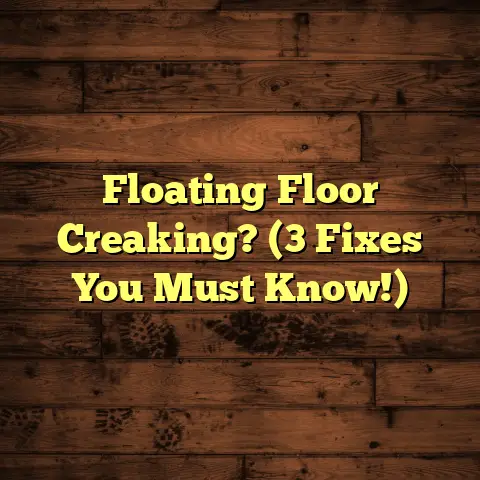Repair Scratched Vinyl Plank Floor? (Explained)
Repairing scratched vinyl plank flooring can be a surprisingly straightforward process, but it requires a bit of know-how and access to the right tools. I’ve spent years in the flooring business, and I want to share my experiences, tips, and tricks for tackling this issue head-on. Let’s dive deep into the world of vinyl plank flooring repairs and explore practical solutions to restore your floors to their original glory.
Understanding Vinyl Plank Flooring
Vinyl plank flooring has gained immense popularity over the years, thanks to its versatility and durability. It mimics the appearance of hardwood while providing resistance to moisture and wear. I remember when I first introduced vinyl planks to my clients; they loved the way it looked and felt underfoot. It was a game-changer for many homeowners.
However, even with its robust construction, vinyl plank flooring is not impervious to damage. Scratches can happen for various reasons—furniture being dragged, pets running around, or even just normal wear and tear. The best-kept secret I’ve discovered is that many scratches can be repaired easily without replacing the entire floor.
Assessing the Damage: How Bad Is It?
The first step in addressing any scratch is to assess how deep it is. This will determine what repair method you should use. Here are some things I consider when evaluating the damage:
- Surface Scratches: These are often light and can usually be repaired with simple cleaning methods or minor touch-ups. If you run your fingernail across the scratch and it doesn’t catch, you’re in luck!
- Deeper Scratches: If the scratch feels deeper or you can catch it with your nail, it may require sanding or filling. This is where things get a little more involved.
- Gouges or Chips: If you have significant damage, such as gouges or pieces missing from the planks, you might need to replace those specific sections altogether.
Quick Fixes for Light Scratches
For scratches that are merely surface-level, here’s what I typically do:
Step 1: Clean the Area
Before attempting any repair, cleaning the scratched area is crucial. I usually use a soft cloth and a gentle floor cleaner to remove any dust or debris. This prevents dirt from getting pushed into the scratch during the repair process.
Step 2: Magic Eraser
One of my go-to tools is a magic eraser. Wet it slightly and gently rub it over the scratch. The melamine foam works like fine sandpaper, buffing out minor imperfections. After using it, I often notice a significant reduction in the visibility of the scratch.
Step 3: Apply Vinyl Floor Repair Kit
If the scratch is still visible after using the magic eraser, I recommend using a vinyl floor repair kit that matches the color of your planks. These kits usually contain putty that can fill deeper scratches effectively. Follow the instructions carefully—typically, you press it into the scratch and smooth it out with a plastic scraper.
Dealing with Deeper Scratches
When faced with deeper scratches, a more hands-on approach is necessary:
Step 1: Sanding
For scratches that are more pronounced, I often resort to sanding. Using fine-grit sandpaper (220 grit) helps smooth out the edges of the scratch. It’s essential to be gentle during this process; we want to avoid removing too much material from the plank.
Step 2: Cleaning Again
After sanding, I always clean the area again to remove any leftover dust or debris. A clean surface allows for better adhesion of repair materials.
Step 3: Color Matching
This is where things can get tricky but also fun! I take my time mixing colors from different repair kits to find the perfect match for my vinyl planks. It’s like being an artist; patience pays off here.
Step 4: Filling the Scratch
With the color matched, I apply the putty over the scratch, ensuring it’s packed in firmly and level with the surrounding area.
Step 5: Sealing
Once the putty dries completely, I usually finish up by applying a sealant over the repaired area to protect it from future damage.
Challenges in Repairing Vinyl Plank Flooring
While repairing scratched vinyl plank flooring can be straightforward, I’ve faced my share of challenges throughout my career. One memorable project involved a client who had extensive scratches across multiple planks due to pet damage. It was clear that some areas would need more than just a touch-up.
After assessing the situation, we decided on a combination of sanding and patching for some scratches but also agreed to replace several planks entirely where damage was too severe to repair effectively. It was a tough conversation, but transparency about what could be salvaged versus what needed replacement built trust with my client.
The Importance of Transparency
In situations like these, honesty is key. I’ve learned that clients appreciate knowing their options upfront rather than feeling misled about what can be done. By being transparent about costs, timeframes, and potential outcomes, I help clients make informed decisions.
Cost Estimation with FloorTally
One aspect that often comes into play during repairs is budgeting. This is where FloorTally has been invaluable for me over the years. When working on repairs or new installations, I use FloorTally for accurate cost estimations.
For instance, when determining whether to repair or replace damaged planks, FloorTally allows me to input various scenarios and compare costs effortlessly. This means I can provide clients with realistic budgets based on local material prices and labor rates.
I remember one particular project where we had to decide on replacing several damaged planks versus attempting repairs. With FloorTally’s data on hand, I was able to show my client a detailed breakdown of costs for each option, making it easier for them to choose what worked best for their budget.
Comparing Repair Methods
Over my years in flooring, I’ve experimented with various methods for fixing scratches:
- Magic Eraser vs. Sanding: For lighter scratches, magic erasers have become my go-to tool due to their ease of use and effectiveness. However, sanding is necessary for deeper scratches but requires more skill and care.
- Vinyl Repair Kits vs. DIY Solutions: Pre-made repair kits are great for color matching but can be expensive. On some occasions, I’ve successfully used DIY solutions using common household items like toothpaste or baking soda mixed with water for minor scratches—an economical choice when money is tight.
Maintenance Tips: Preventing Future Damage
Once you’ve repaired those scratches, keeping your vinyl planks in top condition is crucial to prevent future issues:
- Use Furniture Pads: Always place pads under furniture legs to avoid future scratches from movement.
- Regular Cleaning: Sweep or vacuum regularly to remove dirt that can scratch the surface over time.
- Avoid Harsh Chemicals: Stick to gentle cleaners specifically designed for vinyl floors to maintain their integrity.
Real-Life Stories: Successes and Lessons Learned
Every repair project comes with its own set of experiences that shape how I approach future jobs. One time, I was called in to help with a commercial space that had seen better days—scratches everywhere due to heavy foot traffic.
After assessing the situation, we decided on a multi-faceted approach: we would replace some planks in high-traffic areas while also using repair kits on others where damage wasn’t as severe. The transformation was incredible! The business owner was thrilled with the results—proof that careful planning and execution can yield fantastic outcomes.
On another occasion, I faced a particularly stubborn scratch that seemed resistant to all my usual tricks. After several attempts at sanding and filling without success, I realized it was time for a different approach: complete replacement of that plank! Sometimes admitting defeat leads to better results.
Tools of the Trade: What I Use
Throughout my journey in flooring, I’ve accumulated various tools that make repairs more manageable:
- Magic Eraser: Essential for light surface scratches.
- Sandpaper (220 grit): Perfect for smoothing out deeper marks.
- Vinyl Repair Kits: A must-have for color-matching and filling holes.
- Plastic Scrapers: Useful for smoothing out putty during repairs.
- Sealants: Important for protecting repaired areas from future damage.
Having these tools handy makes any repair job much easier and efficient!
Dealing with Specific Situations
Pet Damage
As a pet owner myself, I understand how easily pets can cause damage to floors. Whether it’s playful scratching or an accident that leaves stains, vinyl plank flooring can withstand quite a bit if treated correctly.
For pet-related scratches:
- Regular Grooming: Keep your pet’s nails trimmed to minimize scratches.
- Designated Play Areas: Create specific areas where pets can play without damaging floors.
If damage occurs despite precautions, follow standard procedures for repairing scratches as outlined earlier.
Water Damage
Water damage is another common concern with vinyl plank flooring. Although it’s generally resistant to moisture, prolonged exposure can lead to problems like warping or discoloration.
If you encounter water damage:
- Dry Immediately: The quicker you dry out any spills or leaks, the better.
- Inspect Planks: Check for warping or bubbling; if present, those planks may need replacement.
- Repair Surface Damage: Use sanding or filling techniques as needed on affected areas.
Heavy Foot Traffic
In commercial settings or busy households, high foot traffic can lead to quicker wear and tear on vinyl flooring:
- Regular Maintenance: Schedule routine cleanings to keep dirt from accumulating.
- High-Quality Mats: Use mats at entryways to capture dirt before it reaches your floors.
- Strategic Layouts: Consider furniture arrangements that minimize direct traffic over vulnerable areas.
Conclusion: Finding Balance in Repair Options
Repairing scratched vinyl plank flooring doesn’t have to be overwhelming or costly when you know what steps to take. With a mix of household supplies and professional tools at your disposal—and perhaps some help from FloorTally for budgeting—you can keep those floors looking great for years to come.
Every scratch tells its own story; whether from moving furniture around or playful pets running through your home—they’re part of life! By taking proactive measures now and following these tips for maintenance down the line, you’ll enjoy beautiful vinyl floors long into the future!





